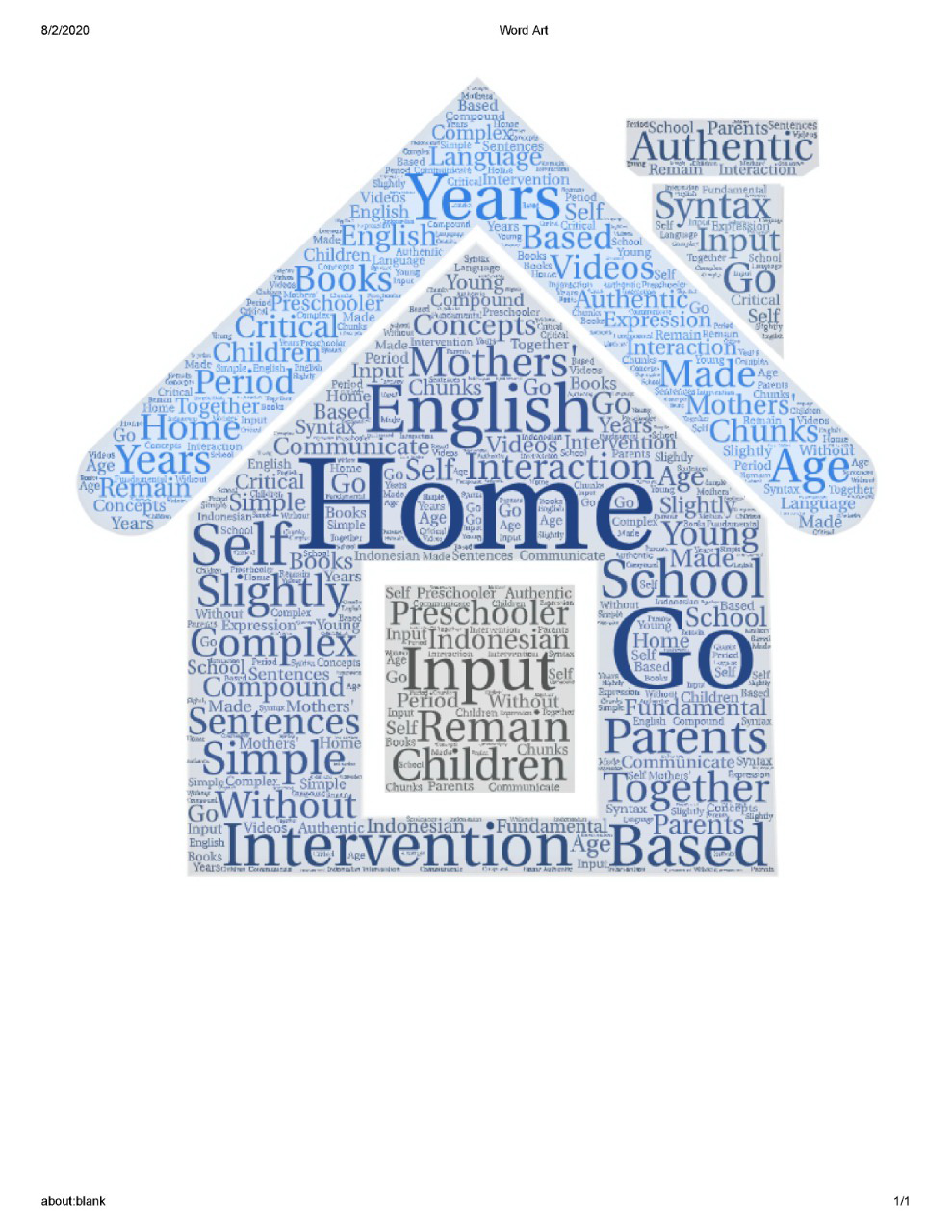A home-based intervention towards preschoolers’ EFL sentence development
DOI:
https://doi.org/10.21070/jees.v6i1.779Keywords:
home-based intervention; preschoolers; EFL; sentences; developmentAbstract
Research has shown that the initial few years of children’s lives are the best times for language to develop at a rapid pace, the first language (L1) or a foreign language (FL) may be acquired these times. Researches on preschoolers FL acquisition with home-based intervention (HBI) have not been studied extensively under the L1 environment. This study aims to examine the results of HBI on the development of the acquisition of Indonesian preschoolers’ English as a Foreign Language (EFL) sentences. This research is a case study with naturalistic observation design, where data were obtained from logbooks and interview. The research subjects were 2 preschoolers about 36 months. The study’s duration was 24 months from the 13th until the 36th month with HBI, namely parents-based and authentic/semi authentic-media intervention. The data were the children’s English sentences taken at 24th to 36th months at their own homes. The Owens’ acquisition of sentence forms measured the English sentences’ development of in the respondents’ conversation and self-narration. This research found that at about 36th month, these Indonesian preschoolers were able to communicate in English in various sentences such as declarative, negative, interrogative, imperative, embedded and conjoining.
HIGHLIGHTS:
- Simultaneous foreign language learning and first language acquisition for children is tangible advantage.
- Authentic input and active interaction act as the language environment substitute in foreign language learning.
- Intensive learning makes preschoolers speak a foreign language earlier.
Downloads
References
Astutik, Y., Megawati, F., & Aulina, C. N. (2019). Total physical response (TPR): How is it used to Teach EFL Young Learners? International Journal of Learning, Teaching and Educational Research, 18(1), 92–103. https://doi.org/10.26803/ijlter.18.1.7
Beller, S. (2008). Fostering language acquisition in daycare settings. In Early Childhood Development.
Brito, N. H. (2017). Influence of the Home Linguistic Environment on Early Language Development. Policy Insights from the Behavioral and Brain Sciences, 4(2), 155–162. https://doi.org/10.1177/2372732217720699
Conboy, B. T., Brooks, R., Meltzoff, A. N., & Kuhl, P. K. (2015). Social Interaction in Infants’ Learning of Second-Language Phonetics: An Exploration of Brain-Behavior Relations. Developmental Neuropsychology, 40(4), 216–229. https://doi.org/10.1080/87565641.2015.1014487
Cozby, P. C., & Bates, Sc. C. (2015). Methods in Behavioral Research (12th ed.). Mc Graw Hill Education.
Craik, F. I. M., Bialystok, E., & Freedman, M. (2010). Delaying the onset of Alzheimer disease: Bilingualism as a form of cognitive reserve. Neurology, 75(19), 1726–1729. https://doi.org/10.1212/WNL.0b013e3181fc2a1c
Dryden, G., & Vos, J. (1999). The Learning Revolution (2nd ed.). Jalmar Pr.
Ferjan Ramirez, N., & Kuhl, P. (2017). Bilingual Baby: Foreign Language Intervention in Madrid’s Infant Education Centers. Mind, Brain, and Education, 11(3), 133–143. https://doi.org/10.1111/mbe.12144
Frey, L., Botan, C., & Kreps, G. (1999). Summary Chap 10 : Naturalistic Research. Investigating Communication: An Introduction to Research Methods., 257–286. http://mason.gmu.edu/~afinn/html/teaching/courses/f03_comm250/fbk_chapters/10.pdf
Gass, S. M., Behney, J., & Plonsky, L. (2013). Second Language Acquisition: An Introductory Course. Routledge.
Ghasemi, B., & Hashemi, M. (2011). Foreign language learning during childhood. Procedia - Social and Behavioral Sciences, 28, 872–876. https://doi.org/10.1016/j.sbspro.2011.11.160
Indrasari, A., Novita, D., & Megawati, F. (2018). Big Book: Attractive Media for Teaching Vocabulary to Lower Class of Young Learners. JEES (Journal of English Educators Society), 3(2), 141. https://doi.org/10.21070/jees.v3i2.1572
Jennings, D., Hanline, M., & Woods, J. (2012). Using Routines-Based Interventions in Early Childhood Special Education. Dimensions of Early Childhood, 40(2), 13–23.
Marian, V., & Shook, A. (2013). The Cognitive Benefits of Being Bilingual By Viorica Marian , Ph . D ., and Anthony Shook. Cerebrum:The Dana Forum on Brain Science, 10(October 2012), 1–12.
Neuman, S. B., & Wright, T. S. (2014). CHILDHOOD CLASSROOM It ’ s Not Just Baby Talk. 38(2).
Owens, R. E. (2016). Language Development: An Introduction. Pearson.
Pinsonneault, B. C. (2008). Authentic Input in Early Second Language Learning. Thesis, February.
Ramírez-Esparza, N., García-Sierra, A., & Kuhl, P. K. (2017). The Impact of Early Social Interactions on Later Language Development in Spanish–English Bilingual Infants. Child Development, 88(4), 1216–1234. https://doi.org/10.1111/cdev.12648
Ruiz, L. P., & García, C. (2003). Benefits of using authentic materials in an EST class. ES: Revista de Filología Inglesa, 25(25), 183–192.
Scheffler, P. (2015). Introducing very young children to English as a foreign language. International Journal of Applied Linguistics (United Kingdom), 25(1), 1–22. https://doi.org/10.1111/ijal.12035
Steinberg, D. D., & Sciarini, N. V. (2006). An Introduction to Psycholinguistics. Pearson Longman.
Van Balkom, H., Verhoeven, L., Van Weerdenburg, M., & Stoep, J. (2010). Effects of Parent-based Video Home Training in children with developmental language delay. Child Language Teaching and Therapy, 26(3), 221–237. https://doi.org/10.1177/0265659009349978
Verga, L., & Kotz, S. A. (2013). How relevant is social interaction in second language learning? Frontiers in Human Neuroscience, SEP. https://doi.org/10.3389/fnhum.2013.00550

Published
How to Cite
Issue
Section
License
Copyright (c) 2021 Dwijani Ratnadewi, Armeria Wijaya

This work is licensed under a Creative Commons Attribution 4.0 International License.







